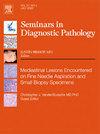Bridging Perspectives: Integrating urologist and cytopathologist insights of urine cytology
IF 3.5
3区 医学
Q2 MEDICAL LABORATORY TECHNOLOGY
引用次数: 0
Abstract
In this comprehensive review, we explore the integration of both cytopathologic and urologic perspectives around interpretation of urine cytology under the Paris System for Reporting Urinary Cytology (TPS) and clinical management. Urine cytology is a pivotal diagnostic tool for urologists, especially in the detection and management of high-grade urothelial carcinoma (HGUC). The review highlights how TPS has standardized urine cytology interpretations through consistent diagnostic criteria and reduced atypical diagnoses. This standardization aids in communication between pathologists and clinicians. There is an educational need to foster more effective collaboration between urologists and cytopathologists. Clinicians are not formally educated about TPS, and guidelines do not exist for how TPS diagnostic categories should impact patient treatment/management. Therefore, as TPS continues to evolve, it is important for pathologists to understand how urologists perceive TPS and use its diagnostic categories. This review addresses the clinical management of various diagnostic categories under TPS, illustrating how urologists integrate urine cytology results with endoscopic and radiologic data to monitor recurrence, progression, and metastasis of bladder cancer. It also covers the adjunctive use of urinary biomarkers and advanced cystoscopic techniques to enhance diagnostic accuracy. By bridging cytopathologic insights with urologic clinical applications, this review provides a holistic understanding of the diagnostic and management strategies for bladder cancer, underscoring the indispensable role of urine cytology in urologic practice.
桥梁观点:整合泌尿科医生和细胞病理学家的尿细胞学见解
在这篇全面的综述中,我们探讨了在巴黎尿细胞学报告系统(TPS)和临床管理下,关于尿细胞学解释的细胞病理学和泌尿学观点的整合。尿细胞学是泌尿科医生的关键诊断工具,特别是在检测和处理高级别尿路上皮癌(HGUC)时。这篇综述强调了TPS如何通过一致的诊断标准和减少非典型诊断来标准化尿细胞学解释。这种标准化有助于病理学家和临床医生之间的交流。培养泌尿科医生和细胞病理学家之间更有效合作的教育需要。临床医生没有接受过TPS方面的正式教育,也没有关于TPS诊断类别如何影响患者治疗/管理的指南。因此,随着TPS的不断发展,病理学家了解泌尿科医生如何看待TPS并使用其诊断类别是很重要的。本文综述了TPS下各种诊断类别的临床管理,阐述了泌尿科医生如何将尿细胞学结果与内窥镜和放射学数据结合起来监测膀胱癌的复发、进展和转移。它还涵盖了辅助使用尿液生物标志物和先进的膀胱镜技术,以提高诊断的准确性。通过将细胞病理学见解与泌尿外科临床应用相结合,本文综述了膀胱癌的诊断和治疗策略的整体理解,强调了尿细胞学在泌尿外科实践中不可或缺的作用。
本文章由计算机程序翻译,如有差异,请以英文原文为准。
求助全文
约1分钟内获得全文
求助全文
来源期刊
CiteScore
4.80
自引率
0.00%
发文量
69
审稿时长
71 days
期刊介绍:
Each issue of Seminars in Diagnostic Pathology offers current, authoritative reviews of topics in diagnostic anatomic pathology. The Seminars is of interest to pathologists, clinical investigators and physicians in practice.

 求助内容:
求助内容: 应助结果提醒方式:
应助结果提醒方式:


